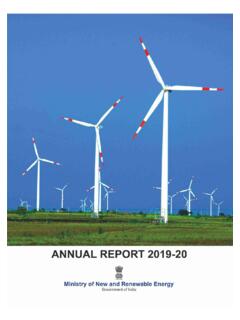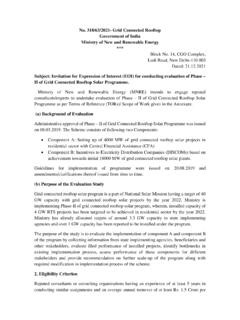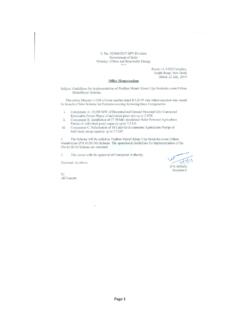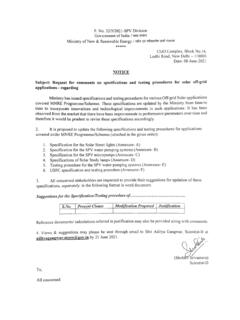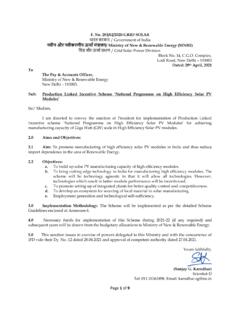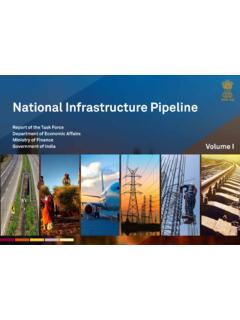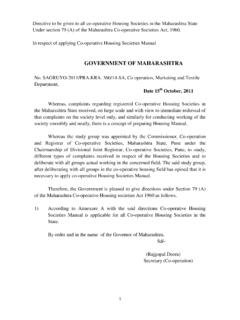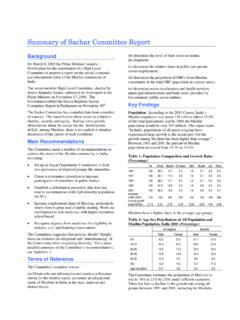Transcription of Government of India Ministry of New and Renewable Energy
1 Government of India Ministry of New and Renewable Energy MNRE 1,00,000 MW Till year 2022 40,000 MW 20,000 MW 20,000 MW 20,000 MW Solar Park Unemployed Graduate States/Private/Others Solar Rooftop Road Map for Solar Power by 2022 MNRE Solar systems installed on rooftops of residential, commercial, institutional & industrial buildings : premises. Electricity generated could be -fed into the grid at regulated feed-in tariffs or -used for self consumption with net-metering approach MNRE Savings in transmission and distribution losses Low gestation time No requirement of additional land Improvement of tail-end grid voltages and reduction in system congestion with higher self-consumption of solar electricity Local employment generation Reduction of power bill by supplying surplus electricity to local electricity supplier Battery elimination makes easy installation and reduced cost of system MNRE In India market potential for rooftop SPV is 124 GW.
2 124 210 352 050100150200250300350400GW Technical PotentialEconomic PotentialMarket Potential MNRE Identification/ Categorization Identification of Ministries, departments & facilities Categorization of structures for roof space mapping Roof space GIS mapping Sample size Roof space mapping Potential estimation Deriving average usable roof area Determining rooftop solar potential Methodology Assumptions: a) 40% of the identified roof space is usable for rooftop solar installation shading, non-uniform north-facing tilt of roof, etc.; b) Roof has sufficient structural load-bearing capacity to support solar system; c) Sufficient capacity is available at distribution transformer level; d) Estimates based on roof-space image mapping from Google Earth. Ministry MW Potential Ministry of Agriculture 12 Ministry of Chemicals and Fertilizers 401 Ministry of Civil Aviation 620 Ministry of Coal 53 Ministry of Commerce and Industry 2 Ministry of Consumer Affairs, Food and Public Distribution 2314 Ministry of Culture 2 Ministry of Defence 281 Ministry MW Potential Ministry of Food Processing Industries 22 Ministry of Health and Family Welfare 45 Ministry of Heavy Industries and Public Enterprises 271 Ministry of Housing and urban Poverty Alleviation 2 Ministry of Human Resource development 497 Ministry of Micro.
3 Small and Medium Enterprises 4 Ministry MW Potential Ministry of Petroleum and Natural Gas 1009 Ministry of Railways 1369 Ministry of Road Transport and Highways Ministry of Shipping 51 Ministry of Steel 224 Ministry of Textiles 5 Ministry of Tourism 6 Ministry of Youth Affairs and Sports 6 TOTAL MW Present Status in India MW of Solar Rooftop Projects sanctioned by MNRE and MW commissioned MNRE Sector Installed by SECI (MW) Installed by States (MW) Total installed (MW) Commercial Government Hospital Institutional (Schools, Collages) Religious institution Residential 0 Total 13 States have come out with Solar Policy supporting grid connected rooftop systems : Andhra Pradesh Chhattisgarh, Gujarat, Haryana, Karnataka, Kerala, Manipur, Punjab, Rajasthan, Uttar Pradesh, Tamil Nadu, Uttarakhand and West Bengal. SERCs of 19 States/UTs have notified regulations for net metering/feed-in-tariff mechanism :- Andhra Pradesh, Chhattisgarh, Delhi, Haryana, Karnataka, Kerala, Tamil Nadu, Uttarakhand and West Bengal, Andaman & Nicobar, Chandigarh, Dadra & Nagar Haveli, Daman & Diu, Lakshadweep, Pondicherry, Goa, UP, Rajasthan and Odisha.
4 Remaining States are requested being pursued to come out with their policies/regulations. MNRE Following remaining States should notify regulations and policy for grid connected rooftop systems:- Arunachal Pradesh, Bihar, Himachal Pradesh, Jammu & Kashmir, Gujarat, Jharkhand, Telangana, Assam, Madhya Pradesh, Maharashtra, Manipur, Meghalaya, Mizoram, Nagaland, Punjab, Sikkim, Tripura department of Financial Services has advised all Public Sector Banks to provide loans for grid connected rooftop solar systems as home loan/ home improvement loan. So far, nine PSBs namely Bank of India , Syndicate Bank, State Bank of India , Dena Bank , Central Bank of India , Punjab National Bank, Allahabad Bank, Indian Bank and Indian Overseas Bank have given instructions to their branches. However, it is yet to be made effective at field level as no branches of these banks are providing such loans. department of Financial Services may issue appropriate instructions to make it more effective.
5 Reserve Bank of India on April 2014 has included Renewable Energy projects under Priority Sector Lending for which bank loans up to a limit of Rs. 15 crore to borrowers will be available for Renewable Energy projects including grid connected solar rooftop and ground mounted systems. For individual households, the loan limit is Rs. 10 lakh per borrower. This is yet to be mad effective at field level. The following benefits are available in commercial & industrial categories:- Custom Duty Concessions Excise Duty Exemptions Accelerated Depreciation Fiscal and other concessions from State Governments 15% CFA is available for residential, institutional and social sectors (1). Available Capacity at Distribution Transformer For Connecting Renewable Energy System for Net Metering by the Distribution Licensee shall not be less than 20% (Twenty percent) of the rated capacity of respective distribution transformer. (2). Procedure for Application and Registration (by DISCOMs) (i) Feasibility Analysis fee of Rs.
6 500/-, within 30 days ii) Registration Consumer To apply in 30 days with charges 1000 to 15000 iii) Connection Agreement To be executed within 30 days from the date of registration between DISCOM and Consumer, (3) Interconnectivity, Standards and Safety shall be governed by the Central Electricity Authority (Measures relating to Safety and Electric Supply), Regulations, 2010, as amended from time to time. (4) Metering Arrangement and Standards Cost of the Net Meter, which is capable of recording both import and export of electricity to be borne by the consumer. Meters shall be Meter Reading instrument (MRI) compliant or AMR (Automatic Meter Reading) or AMI (Advanced Metering Infrastructure) compliant for recording meter readings. (5) Procedure of billing & accounting (a) Non Time of Day Tariff Consumers: surplus units injected by the consumer shall be carried forward to the next billing period as Energy credit and shown as Energy exported by the consumer for adjustment against the Energy consumed in subsequent billing periods within the settlement period.
7 (b) Time of Day Tariff Consumers The electricity consumption in any time block ( , peak hours, off-peak hours, etc.) shall be first compensated with the electricity generation in the similar time blocks in the same billing cycle. If the consumer is injecting Energy in the peak hours or in a time block when Distribution Licensee is having more demand than the available Energy , Distribution Licensee with the approval of the Commission may propose incentives to such consumers (6) Tariff at the end of financial year for surplus Energy The Consumer shall be paid for net Energy credits which remain unadjusted at the end of the financial year at the rate of Average Power Purchase Cost (APPC) (7) Theft and Tempering of Meter(s) As per Electricity Act 2003 (8) Dispute Resolution : by DERC (9)Violation of guidelines : Penalty as decided by DERC (10) Powers to amend : DERC Andhra Pradesh Solar Power Policy, 2015 Implementation of projects on gross and or net meter basis Consumer(s) are free to choose either net or gross meter option Applicable tariff will be determined by APERC every year APERC tariff for FY 2013-14 is Rs per unit for 25 years Metering facility will be extended for all Eligible Developers via online mode to DISCOM Approvals/clearances shall be disposed by the respective Discom within 14 days from the date of application The projects of capacity upto 1000 KWp at a single location will be permitted The DISCOMs will deduct Energy from the consumed Energy and balances (either excess or lower) can be billed on net metering basis.
8 No Distribution losses and charges will be collected from the Group/Society/ individuals by the DISCOMs. Eligible Developers are allowed to avail the relevant subsidies and incentives from MNRE under JNNSM scheme Modalities for implementing the rooftop policy including metering, billing, settlement, payment(s) and technical aspect will be issued by APEPDCL Existing Policies in Different States MNRE Haryana Electricity Regulatory Commission (HERC) Regulations for the Grid Connected Solar Rooftop Photovoltaic System dated on 24th Nov, 2014: Implementation of projects on net meter basis Application processing fee Rs. 1000/- under net metering arrangement Permission shall normally be granted within 15 days from the date of submission of the application Maximum installed capacity shall not exceed 1 MWp for a single eligible consumer Cumulative capacity of rooftop solar systems shall not exceed 15% of the peak capacity of the distribution transformer.
9 Interconnection of the Renewable Energy System as per CEA (Technical Standards for connectivity of the Distributed Generation Resources) Meters shall adhere to the standards as specified in CEA (Installation and Operation of meters) Regulations, 2010 as amended from time to time. Electricity generated from a rooftop solar system shall be cumulatively capped at 90% of the electricity consumption by the consumer and settlement by the same financial year No carry forward to the next financial year. Licensee eligible for Renewable Purchase Obligation (RPO) under Net-metering policy Subsidy, if any, for Rooftop Solar Grid Interactive System based on Net Metering shall be in accordance with the prevailing policy of the Central/State Government or any other Government agencies. Grid-connected SPV Rooftop systems MNRE Arizona Non Residential - Credited to customer's next bill at retail rate; excess reconciled annually at avoided-cost rate Residential - Credited to customer's next bill at retail rate; excess reconciled annually in April at average annual market price minus price adjustment.
10 California Credited to customer's next bill at retail rate (Option of roll over credit indefinitely or settlement @ 12-month average spot market price) Hawaii Credited to customer's next bill at retail rate; granted to utility at end of 12- month billing cycle MNRE Italy Mechanism does not result in direct payments and is based on the balance of the Energy fed in and consumed - Credit is unlimited in terms of time. France Commercial settlement for a defined level of excess injection - limit is worked out according to formulas that take into account the installed peak capacity reached after a number of working hours for different types of installations and locations Virginia, USA Settlement Period: At the end of 12-month period, customer has the option of carrying forward eligible excess NEG to the next net metering 12-month period or Selling to utility. Credit to be carried forward to subsequent net metering period can not exceed amount of Energy purchased during the previous annual period.
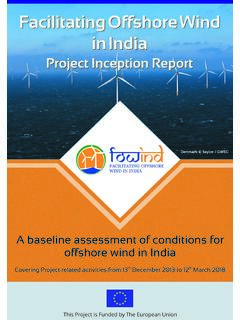
![No.283/54/2018-GRIDSOLAR-Part(2) JR/ 7@hr3jl ad]aufa ...](/cache/preview/e/9/9/f/e/5/f/4/thumb-e99fe5f40795c445f6a2c1028ca812b2.jpg)
